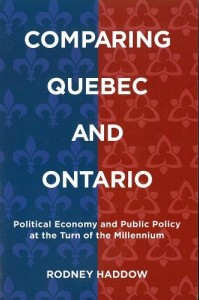Globalization, phooey.
If our century is a march to international corporatism and conformity, why do such vastly different societies thrive on opposite banks of the Ottawa River? In this book of dissent, political scientist Rodney Haddow of the University of Toronto documents the striking absence of anything resembling globalization in our own neighbourhood. It’s a neat proposition.
First, the facts. Ontario and Québec combined have a population of 22 million, only slightly less than Australia and twice the size of Greece.
All provinces now control a majority of government revenues nationwide, about 57 percent. Premiers, not Parliament, pretty much run the country under terms of Confederation that were never appreciated at the time. Haddow explains, “The Constitution Act 1867 grants the federal government almost unlimited fiscal authority while requiring the provinces to rely primarily on direct taxes. The provinces were assigned most social responsibilities, but these were considered to be modest in nineteenth-century Canada.”
In John A. Macdonald’s day most revenues came from tariffs – income tax was considered revolutionary – and the only welfare program per se was the voting of annuities to widows of federal judges. “Social responsibilities became much more important in Canada as it constructed a modern welfare state after 1945,” Haddow writes. “The provinces’ capacity to raise funds from their own resources grew substantially and was complemented by rapid program expansion.”
Here the trail takes a winding course.
Comparing Quebec And Ontario documents widely different postwar societies built by neighbours. You’d struggle to find two states within the European Union that have more diverse governments.
Québec has a higher rate of union membership; less foreign trade; an older population; fewer immigrants; more debt; a similar jobless rate; higher taxes but better benefits for families. The last point is spectacular. In 2011 a single mother received $4,078 in benefits in Québec but only $1,860 in Ontario.
Childcare in 2002 cost $3,600 in Ontario, but only $1,400 in Québec. True, one province received more federal transfers than the other, Haddow notes, but that does not explain the contrasting values in where they spent the money.
In a single year, 1986, more than 10 percent of the entire province of Québec received social assistance. Ontario by comparison in the 1992-93 recession cut operational spending by one-tenth and fired 5,000 public servants.
Why? Haddow attributes the gulf to “dissimilar party systems”; there is comparatively little daylight between most Québec politicians on issues of taxing and spending, while Ontarians can still argue over the minimum wage.
“These results are resilient in the face of controls for globalization and post-industrialism,” Haddow concludes; “Differences between Ontario and Québec do not disappear when we control for the impact of globalization and post-industrialism, separately or together. These forces are not causing our provinces to converge.”
In Geneva and Brussels and Tokyo globalization is all the rage. Yet it dies on the right lane of the Champlain Bridge as you cross the Ottawa River.
By Holly Doan
Comparing Quebec And Ontario: Political Economy and Public Policy at the Turn of the Millennium, by Rodney Haddow; University of Toronto Press; 392 pages; ISBN 9781-4426-27017






